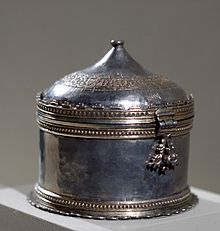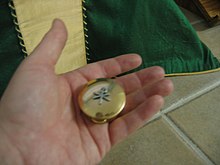Pyxis (liturgy)

Silver pyxis from southern France or Spain with gilded decorations, 15th century, Musée de Cluny .
A Pyxis is a small liturgical vessel in which consecrated wafers in tabernacle for the administration of the communion be stored, or the Priest or communion helper for the sick communion carries with him.
The pyxis is often designed as a lavishly decorated, metal, inside gold-plated box.
In the past, the pyxis sometimes took the form of a tower as an artistic replica of the Holy Sepulcher , but almost always had a cylindrical shape . It had a tent-like lid and was often decorated with reliefs. Precious so-called host doves, whose shape alludes to the Holy Spirit in the form of a dove, have also been preserved.
literature
- Joseph Braun : The Christian altarpiece in its being and in its development. Munich 1932.
Individual evidence
- ↑ “According to the conditions of the church and the legal local customs, the most holy sacrament should be kept in a tabernacle [...]. Furthermore, all regulations of the liturgical books and the norms of law should be carefully observed, especially to avoid the risk of profanation. [...] About the prescriptions of can. 934 § 1, it is forbidden to keep the most holy sacrament in a place that is not under the safe authority of the diocesan bishop or where there is a risk of profanation. If this is the case, the diocesan bishop must immediately revoke the already granted authority to keep the Eucharist ”(Instruction Redemptionis sacramentum - about some things regarding the Most Holy Eucharist to be observed and avoided , 130 f. Online ).
Web links
Commons : Pyxis - collection of images, videos and audio files
Commons : Host Pigeon - Collection of images, videos and audio files

